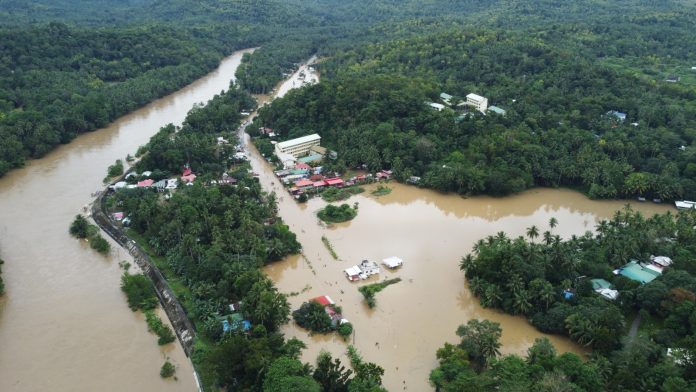Congressmen budgeted PhP183 billion for “flood controls” in 2023. They’ll pocket most of it.
Congressional pork barrels are mainly in Flood Management Programs (FMP). Rivers are to be dredged, but none actually takes place. No state auditor checks if mud and silt were removed.
Supermajority congressmen will divvy up the PhP183 billion FMP. The closer to the top the congressman is, the bigger the share. For “pakisama,” some nano-minority members will be handed pork slices.
The PhP183 billion is inserted in the Department of Public Works and Highways budget. Congressmen negotiated their FMPs during budget committee hearings. Only regional directors and district engineers know exactly how much will go to this influential congressman or that lightweight. An engineering district consists of one or more congressional districts.
FMP funds have been allocated since Congress’ 1987 restoration. Most were stolen. Instead of abating, floods have spread. Congressmen welcome inundations of homes, shops, and farms – justifications for more FMPs the following year.
A district’s flood budget grows each year of the congressman’s tenure. It continues to swell as the spouse, offspring, parent, or sibling inherits the congressional seat. As long as there are political dynasties, there will be floods to control. For them it doesn’t pay to solve flooding.
Senators partake of FMPs. More pork barrels are “parked” in other departments, like health and social welfare.
Pork barrels have ballooned ever since outlawed by the Supreme Court in 2013. The Supreme Court defined it as lump sums, no details of projects concocted by legislators after budget enactment.
Originally those were fixed amounts. Emerging in 1989, the Countryside Development Fund was PhP80 million per senator and PhP50 million per congressman. City lawmakers demanded their share. It was renamed Countrywide Development Fund, and increased to PhP100 million per senator and PhP60 million per congressman.
CDFs rose in the 2000s: PhP150 million per senator, PhP70 million per congressman. It became Priority Development Assistance Fund: PhP200 million per senator, PhP80 million per congressman. Then, Disbursement Acceleration Program; same fixed amounts for senators and congressmen, plus insertions in various agencies.
FMPs are now permanent entries in national budgets. “Flood contractors” have become congressmen. Adept at it, they wangle bigger FMPs than most. They “buy” colleagues’ FMPs, advancing 80-percent kickbacks to the latter and keeping 20-percent “handling fee.” They do fake feasibility studies and completion reports, and onsite props like idle dredgers, hard hat workers and billboards. Imagine Janet Lim-Napoles sitting in Congress.
Dredging actually is measurable. Diligent engineers first compute the project length, width and depth, then recompute the dredged dimensions. They countercheck this with the dredger’s operating capacity and duration.
The national budget has no such descriptions. FMPs just come in two generic forms: “construction/maintenance of flood mitigation structures and drainage systems” and “construction/rehabilitation of flood mitigation facilities within major river basins and principal rivers”. Only provinces, cities, and engineering districts are itemized.
Taxpayers can ask how their congressmen use FMPs.
FMPs are all flat peso amounts. Some don’t have ones, tens, hundreds, thousands – only millions. Examples:
• Ilocos Norte 1st engineering district, exactly PhP780,000,000;
• Ilocos Sur 2nd ED, exactly PhP471,000,000;
• Pangasinan 3rd ED, PhP240 million flat;
• Pangasinan 4th, PhP980 million flat;
• Isabela 1st, PhP300 million;
• Isabela 4th, PhP565 million;
• Nueva Vizcaya ED, PhP450 million;
• Bataan 1st, PhP350 million;
• Bulacan 2nd, PhP120 million;
• Pampanga 2nd, PhP210 million;
• Pampanga 3rd, PhP689 million;
• Tarlac ED, PhP215 million;
• Tarlac 2nd, PhP227 million;
• Zambales 1st, PhP150 million;
• Quezon City 1st, PhP680 million;
• Batangas 4th, PhP165 million;
• Rizal 1st, PhP775 million;
• Rizal 2nd, PhP100 million;
• Marinduque, PhP348 million;
• Mindoro Occidental, PhP234 million;
• Romblon, PhP620 million;
• Albay 1st rehabilitation, PhP272 million;
• Masbate 2nd, PhP225 million;
• Masbate 3rd, PhP352 million;
• Aklan rehabilitation, PhP428 million;
• Bacolod ED, PhP502 million;
• Negros Oriental 1st rehab, PhP90 million;
• Negros Oriental 2nd rehab, PhP275 million;
• Negros Oriental 3rd rehab, PhP430 million;
• Bohol 2nd, PhP220 million;
• Bohol 2nd rehab, PhP240 million;
• Cebu 2nd, PhP35 million;
• Cebu 3rd, PhP269 million;
• Cebu 5th, PhP150 million;
• Cebu City, PhP235 million;
• Biliran, PhP305 million;
• Leyte 1st rehab, PhP150 million;
• Zamboanga City ED, PhP552 million;
• Zamboanga del Sur 1st, PhP125 million;
• Zamboanga del Sur 2nd, PhP450 million;
• Zamboanga Sibugay rehab, PhP200 million;
• Cagayan de Oro 1st, PhP145 million;
• Misamis Occidental 2nd, PhP250 million;
• Sultan Kudarat 1st, PhP200 million.
Aside from millions, other FMPs have thousands, but still rounded figures with no ones, tens and hundreds. Some are larger than those above. Complete list in DBM website, 2023 General Appropriations Act, Volume I-B, pages 94-104: https://www.dbm.gov.ph/…/general…/gaa-volume-ib
Sources in and out of government, all preferring anonymity, helped in this research. Staunchly against corruption and pork barrels, they need our prayers for fortitude and protection. (Ask your congressman how he will spend the flood control money in your district.)
Jarius Bondoc is an award-winning Filipino journalist and author based in Manila. He writes opinion pieces for The Philippine Star and Pilipino Star Ngayon and hosts a radio program on DWIZ 882 every Saturday. Catch Sapol radio show, Saturdays, 8 to 10 a.m., DWIZ (882-AM).
The views expressed in this article are the opinions of the author and do not necessarily reflect the editorial stance of LiCAS.news.









